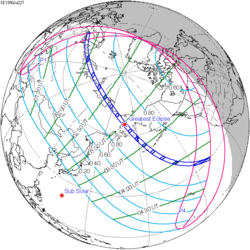| Total eclipse | |
| Gamma | 0.3942 |
|---|---|
| Magnitude | 1.0684 |
| Maximum eclipse | |
| Duration | 318 s (5 min 18 s) |
| Coordinates | 23°24′N62°48′W / 23.4°N 62.8°W |
| Max. width of band | 241 km (150 mi) |
| Times (UTC) | |
| Greatest eclipse | 16:57:53 |
| References | |
| Saros | 136 (42 of 71) |
| Catalog # (SE5000) | 9732 |
A total solar eclipse will occur at the Moon's descending node of orbit on Monday, September 14, 2099, [1] with a magnitude of 1.0684. A solar eclipse occurs when the Moon passes between Earth and the Sun, thereby totally or partly obscuring the image of the Sun for a viewer on Earth. A total solar eclipse occurs when the Moon's apparent diameter is larger than the Sun's, blocking all direct sunlight, turning day into darkness. Totality occurs in a narrow path across Earth's surface, with the partial solar eclipse visible over a surrounding region thousands of kilometres wide. Occurring about 5 hours before perigee (on September 15, 2099, at 12:20 UTC), the Moon's apparent diameter will be larger. [2]
Contents
- Locations experiencing totality
- British Columbia
- Alberta
- Saskatchewan
- Montana
- North Dakota
- Minnesota
- Wisconsin
- Illinois
- Michigan
- Indiana
- Ohio
- Pennsylvania
- West Virginia
- Virginia
- North Carolina
- Eclipse details
- Eclipse season
- Related eclipses
- Eclipses in 2099
- Metonic
- Tzolkinex
- Half-Saros
- Tritos
- Solar Saros 136
- Inex
- Triad
- Solar eclipses of 2098–2101
- Saros 136
- Metonic series
- Tritos series
- Inex series
- Notes
- References





































































































